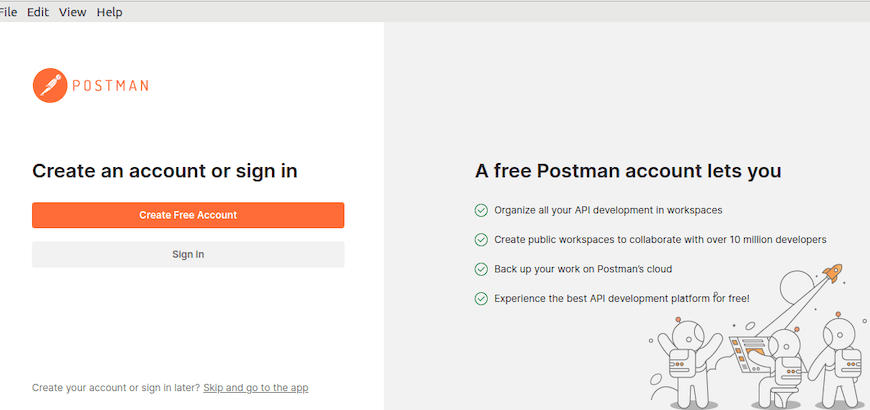How To Install Postman on CentOS Stream 10

In this tutorial, we will show you how to install Postman on CentOS Stream 10. Postman has become an indispensable tool for developers and testers working with APIs. Whether you’re building, testing, or documenting APIs, Postman streamlines these processes with its intuitive interface and powerful features. For Linux users, particularly those running CentOS Stream 10, installing Postman requires following specific procedures to ensure proper functionality. This comprehensive guide walks you through multiple installation methods, configuration steps, and troubleshooting tips to get Postman up and running smoothly on your CentOS Stream 10 system.
What is Postman?
Postman is a comprehensive API platform designed for building, testing, and documenting APIs. Originally developed as a simple Chrome extension for testing REST endpoints, Postman has evolved into a full-fledged application that supports the entire API lifecycle.
With Postman, developers can create requests, organize them into collections, automate testing, mock servers, monitor performance, and collaborate with team members. The platform supports various authentication methods, request types, and provides powerful scripting capabilities through pre-request scripts and test scripts.
Over 30 million developers and 500,000 organizations worldwide use Postman for their API development needs. The platform offers both free and paid tiers, with the free version providing ample functionality for individual developers and small teams.
Understanding CentOS Stream 10 Compatibility
CentOS Stream 10 is the latest in the Red Hat Enterprise Linux (RHEL)-based ecosystem, serving as the upstream development platform for future RHEL releases. This distribution offers cutting-edge features while maintaining stability, making it an excellent choice for development environments.
When it comes to software installation, CentOS Stream 10 uses the DNF package manager, which is the successor to YUM. While Postman isn’t available in the default repositories, there are several methods to install it:
- Using Snap packages (recommended)
- Manual installation
- Postman CLI installation
Each method has its advantages, and your choice depends on your specific requirements and system configuration. The Snap method provides automatic updates, while manual installation offers more control over the installation process.
Prerequisites for Installation
Before installing Postman on CentOS Stream 10, ensure your system meets the following requirements:
- 64-bit system architecture
- At least 4GB of RAM
- Minimum 2GB of available disk space
- Internet connection for downloading packages
- Root access or a user with sudo privileges
- Updated system packages
To update your system packages, run:
sudo dnf updateAdditionally, you’ll need to install the EPEL repository, which provides additional packages not included in the standard repositories:
sudo dnf install epel-releaseThese prerequisites ensure a smooth installation process and optimal performance once Postman is installed.
Method 1: Installing Postman via Snap Package
The recommended method for installing Postman on CentOS Stream 10 is using Snap packages. Snaps are containerized software packages that include all dependencies, making them easy to install and automatically updated.
Installing the Snap Daemon
Before installing Postman, you need to set up the Snap daemon:
- Install snapd from the EPEL repository:
sudo dnf --enablerepo=epel -y install snapd- Enable and start the snapd service:
sudo systemctl enable --now snapd.service snapd.socket- Create a symbolic link for snap:
sudo ln -s /var/lib/snapd/snap /snap- Set up the PATH environment variable:
echo 'export PATH=$PATH:/var/lib/snapd/snap/bin' > /etc/profile.d/snap.sh- Either log out and log back in or restart your system to ensure snap’s paths are updated correctly.
Installing Postman using Snap
Once Snap is set up, installing Postman is straightforward:
sudo snap install postmanThe installation process may take a few minutes as Snap downloads and installs Postman and its dependencies. After installation, you can verify that Postman is installed by running:
snap listThis command will display all installed Snap packages, including Postman.
Accessing Postman
After successful installation, you can launch Postman from the application menu or by typing postman in the terminal. The first time you launch Postman, it might take a bit longer to start as it completes the setup process.
Method 2: Manual Installation of Postman
If you prefer not to use Snap, you can manually install Postman. This method gives you more control over the installation process but requires manual updates.
- Download the latest Postman package from the official website using wget:
wget https://dl.pstmn.io/download/latest/linux64 -O postman-linux-x64.tar.gz- Create a directory for Postman:
sudo mkdir -p /opt/apps/- Extract the tarball to the created directory:
sudo tar -xzf postman-linux-x64.tar.gz -C /opt/apps/- Create a symbolic link to make Postman accessible from the command line:
sudo ln -s /opt/apps/Postman/Postman /usr/local/bin/postman- Create a desktop entry for Postman:
cat > ~/.local/share/applications/postman.desktop << EOL
[Desktop Entry]
Encoding=UTF-8
Name=Postman
Exec=/opt/apps/Postman/Postman
Icon=/opt/apps/Postman/app/resources/app/assets/icon.png
Terminal=false
Type=Application
Categories=Development;
EOLNow you can launch Postman from your application menu or by typing postman in the terminal.
Method 3: Installing Postman CLI
The Postman CLI (Command Line Interface) is useful for integrating Postman into CI/CD pipelines and automating API testing. Here’s how to install it on CentOS Stream 10:
- Download and run the installation script:
curl -o- "https://dl-cli.pstmn.io/install/linux64.sh" | shThis script creates a /usr/local/bin directory if it doesn’t exist and installs the postman binary there.
- Verify the installation by checking the version:
postman --versionThe Postman CLI supports the same system requirements as the Postman desktop app and can be used to run collections from the command line.
Post-Installation Configuration
After installing Postman, you’ll need to set up your environment for optimal use:
First-time Setup
When launching Postman for the first time, you’ll be prompted to:
- Create a Postman account or sign in to an existing one
- Choose a workspace (personal or team)
- Select your preferences for UI, themes, and language

Workspace Configuration
Setting up your workspace properly can improve your workflow:
- Create collections to organize your requests
- Set up environments for different testing scenarios (development, staging, production)
- Configure global variables for reuse across collections
- Set up team workspaces if you’re collaborating with others
Performance Optimization
For better performance, especially on systems with limited resources:
- Disable hardware acceleration if experiencing display issues:
- Go to File > Settings (or Settings > General)
- Uncheck “Hardware Acceleration”
- Restart Postman
- Limit the number of requests saved in history to reduce memory usage
Using Postman for API Testing (Basics)
While a full tutorial on using Postman is beyond the scope of this installation guide, here are some basics to get you started:
Creating Your First Request
- Click the “+” button to create a new request
- Enter the request URL
- Select the HTTP method (GET, POST, PUT, DELETE, etc.)
- Add headers if needed
- For POST or PUT requests, add the request body
- Click “Send” to execute the request
Organizing Requests in Collections
Collections help organize related requests:
- Click “New” and select “Collection”
- Name your collection
- Add requests to the collection by creating new ones or saving existing requests
Writing Basic Tests
Postman allows you to write tests using JavaScript:
- In the request builder, click the “Tests” tab
- Write test scripts to validate responses
- Use the built-in testing functions like
pm.testandpm.expect
For example, to test a successful response:
pm.test("Status code is 200", function () {
pm.response.to.have.status(200);
});Updating Postman
Keeping Postman updated ensures you have access to the latest features and security patches.
Updating Snap Installation
If you installed Postman using Snap, updates are applied automatically. However, you can manually check for updates:
sudo snap refresh postmanUpdating Manual Installation
For manual installations, you’ll need to:
- Download the latest version
- Extract it to replace the existing installation
- Restart Postman
Updating Postman CLI
To update the Postman CLI, run the same installation command:
curl -o- "https://dl-cli.pstmn.io/install/linux64.sh" | shThis will replace the existing CLI with the latest version.
Troubleshooting Common Issues
Even with careful installation, you might encounter some issues. Here are solutions to common problems:
Installation Failures
If Snap installation fails:
- Check if snapd is properly installed and running:
systemctl status snapd- Ensure your system has internet connectivity
- Try reinstalling snapd:
sudo dnf remove snapd
sudo dnf install snapdPostman Won’t Start
If Postman doesn’t start after installation:
- Check for error messages in the terminal
- Try clearing Postman’s cache:
rm -rf ~/.config/Postman- For the “IndexedDB schema migration failed” error, delete the Postman configuration directory and restart
Display Issues
For graphical interface problems:
- Disable hardware acceleration in Postman settings
- Check if your system has required graphics libraries:
sudo dnf install mesa-libGLNetwork Connectivity Problems
If Postman can’t connect to APIs:
- Check your internet connection
- Verify proxy settings if you’re behind a proxy
- Ensure firewall rules allow Postman to access the internet
Removing Postman
If you need to uninstall Postman, the process depends on your installation method.
Removing Snap Installation
sudo snap remove postmanRemoving Manual Installation
sudo rm -rf /opt/apps/Postman
sudo rm /usr/local/bin/postman
rm ~/.local/share/applications/postman.desktopCleaning Up Configuration Files
To completely remove all Postman data:
rm -rf ~/.config/PostmanSecurity Considerations
When using Postman for API testing, keep these security best practices in mind:
- Don’t store sensitive API keys or credentials directly in requests
- Use environment variables for sensitive data
- Be cautious when sharing collections that might contain security information
- Keep Postman updated to address potential security vulnerabilities
- Use Postman’s built-in encryption for storing sensitive information
Managing API Keys Securely
For securing API keys and tokens:
- Create environment variables for sensitive values
- Mark variables containing sensitive data as “secret”
- Avoid exporting environments with sensitive data when sharing collections
Congratulations! You have successfully installed Postman. Thanks for using this tutorial for installing the Postman on your CentOS Stream 10 system. For additional help or useful information, we recommend you check the official Postman website.